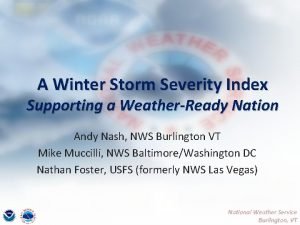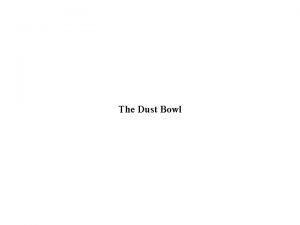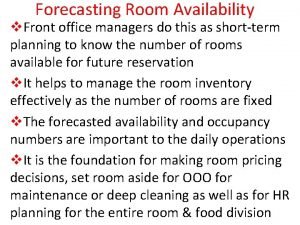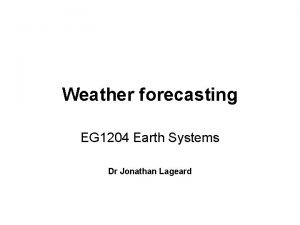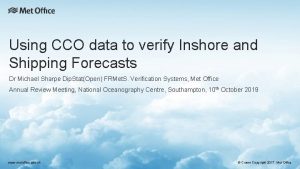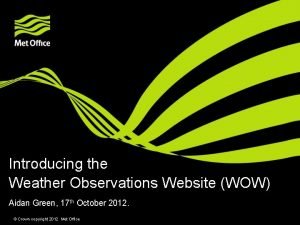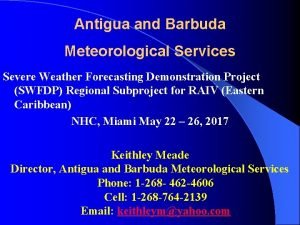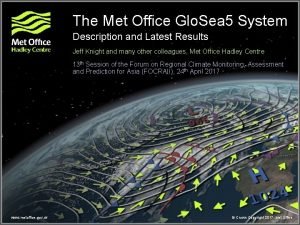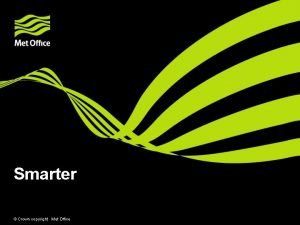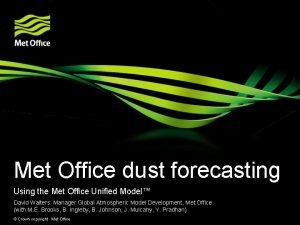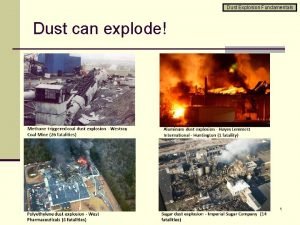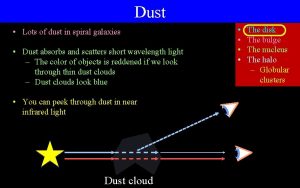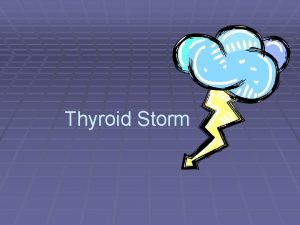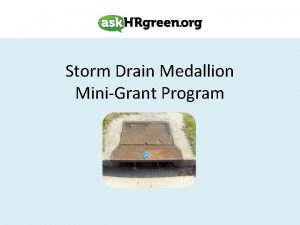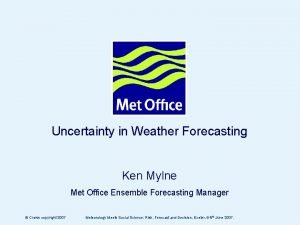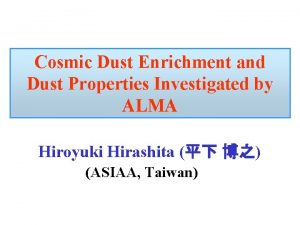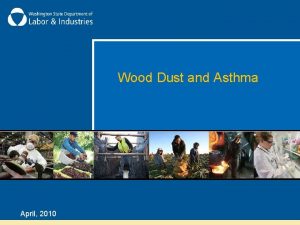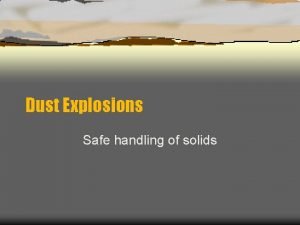Dust storm forecasting at the UK Met Office




































- Slides: 36

Dust storm forecasting at the UK Met Office Castellanetta Marina, Italy, June 2014 Malcolm E. Brooks 1*, Kerry Day 1, Bruce Ingleby 2, Yaswant Pradhan 1, David Walters 1, 1 Met Office, Exeter, UK 2 ECMWF, Reading, UK © Crown copyright Met Office

Global Model Forecasts • N 512 (~25 km) resolution, 70 levels • 4 D VAR ensemblehybrid data assimilation of wind, temperature, humidity etc. • 4 D Var assimilation of MODIS dust obs. over Land • Soil Moisture assimilation uses ASCAT/Synop obs • Dust advected with 2 bins • Forecasts daily at 00 Z and 12 Z, runs for 144 hours © Crown copyright Met Office • N 768 (~17 km) resolution upgrade due July 2014 • N 1024 (~10 km) due in 2016(ish!)

Downscaling the Global capability to high resolution Global (25 km) SAM (12 km) Afghan (4 km) • Global resolution converging on SAM • Implies SAM retirement • Does a higher resolution model work for dust? © Crown copyright Met Office

Downscaling the Global capability to high resolution • Global model drives an Afghan 4 km ‘dynamical downscaler’ • Initialised from global, for every forecast, with global data at boundaries • No independent assimilation of obs © Crown copyright Met Office

Downscaling the Global capability to high resolution • Meant to ‘add detail’ to global forecasts. Does it? • It appears to do that – needs more detailed verification. © Crown copyright Met Office

Downscaling the Global capability to high resolution Consistent performance across global, SAM and 4 km resolutions. © Crown copyright Met Office

Using dust observations to initialise forecasts • 12 km LAMs will be retired in late 2014. • Focus on improving the global model, • either in the forecast model or assimilation of dust observations © Crown copyright Met Office

Assimilation of Dust Observations Merged MODIS “DEEP BLUE” and standard AOD product: • Near global coverage over a day (before filtering). • Uses obs only over land. • Standard MODIS filtered by type. • All DEEPBLUE obs included. • Results from ocean assimilation to come later. © Crown copyright Met Office

Assimilation of Dust Observations: mean behaviour • Test results of re-running global forecasting system for December 2011, into January 2012. • Assimilating MODIS obs mostly adds dust • Esp. over Asia • Dust redistributed in Sahara • Improves skill vs AERONET. • Went operational in April 2013. © Crown copyright Met Office

Upcoming developments global resolution and dynamics • Global model upgrade due in July 2014 includes: • New dynamical core: • Improved solver, slight change of grid. • Less diffusive, more energetic, as forecast evolves. • More expensive, but more scalable on many cores. • Resolution upgrade from N 512 (~25 km) to N 768 (~17 km). • Physics upgrades to improve ‘weather’: surface T, cloud etc. • The most significant NWP upgrade at the Met Office in at least a decade. • No direct impact on dust forecast, • but does the dust forecast maintain skill? • Part of the ‘Global Atmosphere’ (GA) model development process. • Current model is GA 3. 1, upgrading to GA 6. 1. © Crown copyright Met Office

Upcoming developments global resolution and dynamics Current (GA 3. 1) model GA 6. 1 model • Comparison of dust AOD from current operational and resolution/dynamics/physics upgrade (untuned). • No major differences stand out. • Time mean AODs also similar. © Crown copyright Met Office

Current (GA 3. 1) model GA 6. 1 model • Long range forecast drift away from the DA analysis (forecast bias): • Slightly reduced in the GA 6. 1 model. • Forecast model is slightly more consistent with the DA, and hence obs. © Crown copyright Met Office

Upcoming developments global resolution and dynamics Skill scores vs AERONET: • Equitable Threat Score • 0 – no skill • 1 – perfect model. • L 1. 5 data, 1 hr window • Forecast shows skill, and GA 6. 1 neutral to slightly positive. • Poor skill at low AOD events – non dust aerosol? • Moderate dust events improved in GA 6. 1 • ETS always poor for rare events. © Crown copyright Met Office

Upcoming developments Dust interacting with radiation • Proposed model upgrade for late 2014 • Interactive dust used in radiation (instead of climatology). • • No change at analysis time. Bias at T+120 broadly similar, with a dipole pattern over N. Africa. With a slight reduction in biases over N. Africa bias pattern. Small (positive) impact on dust and general forecast evolution. • A reasonable dust climatology does most of the work. • Our dust has reflective optical properties (SSA = ~0. 95 to ~0. 97). © Crown copyright Met Office

Upcoming developments Include MODIS obs. over ocean • Proposed model upgrade for late 2014 • Includes MODIS observations over ocean, in specified regions: • Non dust aerosol filtered using additional MODIS retrievals, using criteria: • Fine Mode Fraction ≤ 0. 4 • Angstrom Exponent ≤ 0. 5 • Effective Radius > 1. 0 μm • Mass Concentration ≥ 1. 2× 10− 4 kg m-2 • AOD > 0. 1 (still under review) • • Bellouin, N. , Boucher, O. , Haywood, J. , and Reddy, M. S. (2005) Global estimate of aerosol direct radiative forcing from satellite measurements Nature, 2005, 438, 1138 -1141. Jones, T. A. , and Christopher, S. A. (2011) A reanalysis of MODIS fine mode fraction over ocean using OMI and daily GOCART simulations, Atmos. Chem. Phys. , 11, 5805 -5817, doi: 10. 5194/acp-11 -5805 -2011 © Crown copyright Met Office

Upcoming developments Include MODIS obs. over ocean • Proposed model upgrade for late 2014 • An example set of MODIS obs, after filtering, for a typical DA cycle. © Crown copyright Met Office

Upcoming developments Include MODIS obs. over ocean GA 6. 1 model + MODIS ocean • Comparison of dust AOD the upcoming GA 6. 1 model, and including MODIS over ocean (plus interactive dust). • Dust is being added in Saharan/other outflow. © Crown copyright Met Office

GA 6. 1 model + MODIS ocean • By improving the analysis, the forecast drift from analysis changes: • Highlights future model developments to improve (long range transport): • Change fallspeeds? size distribution? Retune emissions? Soil properties in © Crown W. copyright Met Office Africa?

Upcoming developments Include MODIS obs. over ocean MODIS Ocean ETS: • Improves all AODs at T+0 • Skill score increase persists to T+24 • and to T+120, • throughout the forecast © Crown copyright Met Office

Upcoming developments Dust included in global ensemble T+0, main run T+120, main run • The GA 6. 1 operational suite is now running, in parallel, for final testing of performance, timeliness and robustness. • Dust included in the global ensemble when this parallel suite was set up. • Global 12 member ensemble, twice daily. • N 400 (~30 km) resolution, forecasts to T+144. © Crown copyright Met Office

T+120 Ensemble Main run T+0 • Individual N 400 ensemble members, broadly comparable to the N 768 main run. © Crown copyright Met Office

Main run Ens. mean • Ensemble mean also broadly comparable to N 768 main run. • Ensemble Std. Dev. is interesting. • This is very much initial work – where do we go from here? • N 400 dust configuration may need tuning. • Ensemble DA now an option for dust. © Crown copyright Met Office

Summary: • Dust forecasting at the Met Office started with Local Area Models for defence applications. • We have since moved to a global model, • which successfully drives dust in high resolution dynamical downscalers. • Global Model forecasts benefit from MODIS dust observations over land (merging standard and DEEPBLUE). • Met Office to upgrade global resolution, dynamical core and model physics. Dust forecast performance is neutral to slightly improved. • Using forecast dust interactively in model radiation gives a very small benefit (relative to a dust climatology). • Assimilating filtered MODIS AOD over ocean gives a larger improvement in dust forecast skill. • Dust now included in our Global Ensemble forecasts, but we are not sure what to do with it yet. © Crown copyright Met Office

Questions? • Dust AOD for 21 Z, Thursday 6 th June 2014, from 12 Z Friday 30 th May. © Crown copyright Met Office

Questions? • Dust AOD for 12 Z, Thursday 6 th June 2014, from 12 Z Friday 30 th May (GA 6. 1, parallel suite) © Crown copyright Met Office

Questions? • Ensemble mean dust AOD for 12 Z, Thursday 6 th June 2014, from 12 Z Friday 30 th May © Crown copyright Met Office

Questions and answers © Crown copyright Met Office

Dust Model Details • NWP only: Verical flux partitioned to bins with prescribed emission size distribution © Crown copyright Met Office

Assimilation of Dust Observations Met Office/Imperial College London AOD retrieval using SEVIRI (MSG): • Uses differences in IR channels • and a radiative transfer model, with 16 days of NWP model data to find a dust-free comparison. • Produces hourly observations. © Crown copyright Met Office

Assimilation of Dust Observations: Assessment • Comparing against AERONET observations. • An ETS of 1 is a perfect forecast • 0 has no skill – this is a hard score as the obs a daylight only, so have a shorter time window than precip verification. • Dust assimilation gives a large increase in skill • Including SEVIRI is not quite right yet. © Crown copyright Met Office

Upcoming developments Dust interacting with radiation • Proposed model upgrade for late 2014 • Interactive dust used in radiation (instead of climatology). • NWP index: an internal metric of large scale global forecast performance • Interactive dust has a small positive impact. © Crown copyright Met Office

Dust emission control from soil properties • Libyan coast dust: regular occurrence in the model, during the 2011 Air campaign • Intense scrutiny of forecasts and SEVIRI pink imagery during this period. • Benghazi was a source, but the coastal dust did not happen! © Crown copyright Met Office

Dust emission control from soil properties Total Vertical flux: Gillette (1979) • Current combination of constraints and data do not give ‘optimal’ results… • Need to look to other soil datasets © Crown copyright Met Office

Dust emission control from soil properties Reprocess current HWSD data? Even old datasets like Zobler 1 degree look useful… Recent datasets like GMINER 30 have a lot more detail. Are they useful? Geomorphology from Digital Elevation Models. © Crown copyright Met Office

Dust emission control from soil properties A preferential source map: • Ginoux (widely used) • Marticorena ’ 97: • or Bullard ’ 11: Both global coverage and high resolution is required. © Crown copyright Met Office

Dry river beds, lakebeds, Wadis e. g. Sistan Basin – often dry • Our emission scheme lacks alluvial sediement… © Crown copyright Met Office
 Winter storm severity index
Winter storm severity index Arthur rothstein fleeing a dust storm
Arthur rothstein fleeing a dust storm Understay rooms represent
Understay rooms represent Met office weather chorley
Met office weather chorley Met office weather selsey
Met office weather selsey Met office
Met office Wow metoffice
Wow metoffice Met office
Met office Antigua met office
Antigua met office Glosea
Glosea Weatherbonk
Weatherbonk Met office
Met office Quá trình desamine hóa có thể tạo ra
Quá trình desamine hóa có thể tạo ra Vẽ hình chiếu vuông góc của vật thể sau
Vẽ hình chiếu vuông góc của vật thể sau Công thức tiính động năng
Công thức tiính động năng Tỉ lệ cơ thể trẻ em
Tỉ lệ cơ thể trẻ em Thế nào là mạng điện lắp đặt kiểu nổi
Thế nào là mạng điện lắp đặt kiểu nổi Dot
Dot Lời thề hippocrates
Lời thề hippocrates Bổ thể
Bổ thể Vẽ hình chiếu đứng bằng cạnh của vật thể
Vẽ hình chiếu đứng bằng cạnh của vật thể độ dài liên kết
độ dài liên kết Các môn thể thao bắt đầu bằng tiếng nhảy
Các môn thể thao bắt đầu bằng tiếng nhảy Sự nuôi và dạy con của hổ
Sự nuôi và dạy con của hổ điện thế nghỉ
điện thế nghỉ Thế nào là sự mỏi cơ
Thế nào là sự mỏi cơ Trời xanh đây là của chúng ta thể thơ
Trời xanh đây là của chúng ta thể thơ Gấu đi như thế nào
Gấu đi như thế nào Số nguyên tố là số gì
Số nguyên tố là số gì Thiếu nhi thế giới liên hoan
Thiếu nhi thế giới liên hoan Phối cảnh
Phối cảnh Các châu lục và đại dương trên thế giới
Các châu lục và đại dương trên thế giới Một số thể thơ truyền thống
Một số thể thơ truyền thống Thế nào là hệ số cao nhất
Thế nào là hệ số cao nhất Sơ đồ cơ thể người
Sơ đồ cơ thể người Tư thế ngồi viết
Tư thế ngồi viết đặc điểm cơ thể của người tối cổ
đặc điểm cơ thể của người tối cổ
